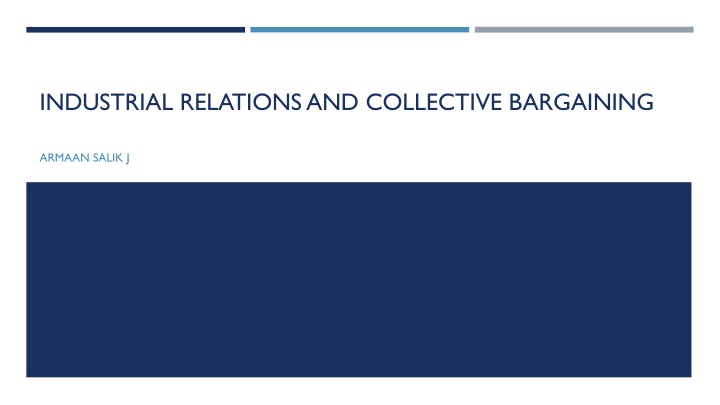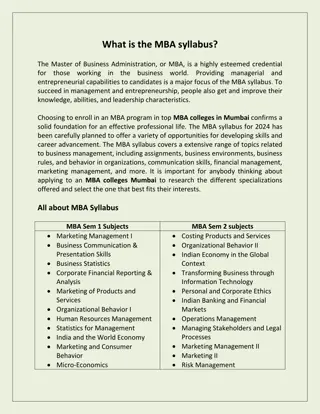
Industrial Relations and Collective Bargaining
Explore the definitions, scope, objectives, and importance of industrial relations along with the meaning, types, and significance of collective bargaining in workplaces. Learn how these aspects promote workplace harmony, enhance productivity, protect employee rights, and foster labor-management cooperation for the betterment of organizations.
Download Presentation

Please find below an Image/Link to download the presentation.
The content on the website is provided AS IS for your information and personal use only. It may not be sold, licensed, or shared on other websites without obtaining consent from the author. If you encounter any issues during the download, it is possible that the publisher has removed the file from their server.
You are allowed to download the files provided on this website for personal or commercial use, subject to the condition that they are used lawfully. All files are the property of their respective owners.
The content on the website is provided AS IS for your information and personal use only. It may not be sold, licensed, or shared on other websites without obtaining consent from the author.
E N D
Presentation Transcript
INDUSTRIAL RELATIONS AND COLLECTIVE BARGAINING ARMAAN SALIK J
INTRODUCTION TO INDUSTRIAL RELATIONS Definition: Industrial Relations (IR) refers to the relationship between employers, employees, and trade unions in an organization. Scope of Industrial Relations: Covers employer-employee interactions, labor laws, grievance handling, and dispute resolution. Objectives of Industrial Relations: Ensure workplace harmony Promote employee welfare Improve productivity Reduce conflicts and disputes
IMPORTANCE OF INDUSTRIAL RELATIONS 1. Promotes Industrial Peace: Reduces strikes, lockouts, and work stoppages. 2. Enhances Productivity: Encourages collaboration between employees and employers. 3. Strengthens Employer-Employee Relations: Ensures open communication and mutual understanding. 4. Encourages Employee Participation: Involves workers in decision-making processes. 5. Ensures Compliance with Labor Laws: Helps organizations adhere to legal regulations and labor policies.
MEANING OF COLLECTIVE BARGAINING Definition: Collective bargaining is the process of negotiation between employers and a group of employees (usually represented by trade unions) to determine wages, working conditions, benefits, and other employment terms. Key Elements: Negotiation Agreement Implementation Dispute resolution
TYPES OF COLLECTIVE BARGAINING: Distributive Bargaining: Focuses on wage and benefit distribution,where one party gains at the expense of the other. Integrative Bargaining: Aims for a win-win situation where both parties benefit through cooperation. Concession Bargaining: Employees accept fewer benefits or wage cuts to help the company during financial difficulties. Productivity Bargaining: Compensation and benefits are linked to employee performance and productivity improvements. Composite Bargaining: Involves discussions beyond wages, including working conditions,job security,and training opportunities.
IMPORTANCE OF COLLECTIVE BARGAINING 1. Protects Employee Rights: Ensures fair wages, job security, and better working conditions. 2. Resolves Workplace Disputes: Provides a structured approach for conflict resolution. 3. Enhances Labor-Management Cooperation: Builds mutual trust between workers and employers. 4. Boosts Economic Growth: Stable labor relations contribute to a strong economy. 5. Encourages Workplace Democracy: Employees have a say in workplace policies and conditions.
FACTORS AFFECTING COLLECTIVE BARGAINING 1. Legal Framework: National labor laws and industrial regulations impact negotiations. 2. Economic Conditions: Inflation, recession, and business profitability influence bargaining power. 3. Strength of Trade Unions: The presence and bargaining strength of labor unions affect negotiation outcomes. 4. Employer s Financial Position: A company s ability to meet wage demands depends on its financial health. 5. Political Environment: Government policies and political stability play a crucial role. 6. Technological Changes: Automation and digital transformation can impact job security and working conditions.
CHALLENGES IN INDUSTRIAL RELATIONS AND COLLECTIVE BARGAINING Resistance from management or employees Unfair labor practices Economic downturns affecting negotiations Lack of skilled negotiators Political and legal interventions
CONCLUSION Industrial Relations and Collective Bargaining are essential for a stable and productive workforce. Effective negotiation ensures fair treatment for employees while maintaining business sustainability. Addressing challenges and fostering cooperation can lead to long-term industrial peace.





















